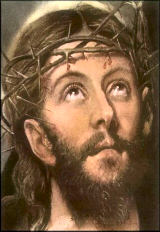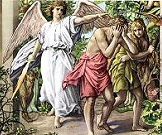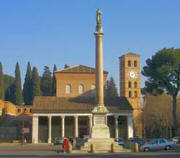Stabat Mater (At the Cross Her Station Keeping)
This 13th-century hymn is variously attributed to Gregory I, Bernard of Clairvaux, Pope Innocent III, St. Bonaventura, Jacopone da Todi, Pope John XXII, and Pope Gregory XI, and others; translated from Latin to English by Edward Caswall (1814-1878). It was the liturgical sequence for the Seven Sorrows of the Virgin (Sept. 15 and the Friday before Palm Sunday). It is no longer used on the Friday before Palm Sunday and is optional on September 15, but it continues to be sung at the Stations of the Cross during Lenten services. It was not admitted as a liturgical sequence until 1727, and musical settings are more numerous after that date.
Stabat Mater Dolorosa is considered one of the seven greatest Latin hymns of all time. It is based upon the prophecy of Simeon that a sword was to pierce the heart of Our Lord's mother, Mary (Lk2:35).
At the cross her station keeping,
Stood the mournful Mother weeping,
Close to Jesus to the last.
Through her heart, His sorrow sharing,
All His bitter anguish bearing,
Now at length the sword had pass'd.
Oh, how sad and sore distress'd
Was that Mother highly blest
Of the sole-begotten One!
Christ above in torment hangs;
She beneath beholds the pangs
Of her dying glorious Son.
Is there one who would not weep,
Whelm'd in miseries so deep
Christ's dear Mother to behold?
Can the human heart refrain
From partaking in her pain,
In that Mother's pain untold?
Bruis'd, derided, curs'd, defil'd,
She beheld her tender child
All with bloody scourges rent.
For the sins of His own nation,
Saw Him hang in desolation,
Till His spirit forth He sent.
O thou Mother! fount of love!
Touch my spirit from above;
Make my heart with thine accord.
Make me feel as thou hast felt;
Make my soul to glow and melt
With the love of Christ our Lord.
Holy Mother! pierce me through;
In my heart each wound renew
Of my Saviour crucified.
Let me share with thee His pain,
Who for all my sins was slain,
Who for me in torments died.
Let me mingle tears with thee,
Mourning Him who mourn'd for me,
All the days that I may live.
By the cross with thee to stay,
There with thee to weep and pray,
Is all I ask of thee to give.
Virgin of all virgins best,
Listen to my fond request
Let me share thy grief divine.
Let me, to my latest breath,
In my body bear the death
Of that dying Son of thine.
Wounded with His every wound,
Steep my soul till it hath swoon'd
In His very blood away.
Be to me, O Virgin, nigh,
Lest in flames I burn and die,
In His awful Judgment day.
Christ, when Thou shalt call me hence,
Be Thy Mother my defence,
Be Thy cross my victory.
While my body here decays,
May my soul Thy goodness praise,
Safe in Paradise with Thee.
Latin
Stabat Mater dolorosa
Juxta Crucem lacrimosa,
Dum pendebat Filius.
Cujus animam gementem,
Contristatam et dolentem,
Pertransivit gladius.
O quam tristis et afflicta
Fuit illa benedicta
Mater Unigeniti!
Quem maerebat, et dolebat,
Pia Mater, dum videbat
Nati paenas inclyti.
Quis est homo, qui non fleret,
Matrem Christi si videret
In tanto supplicio?
Quis non posset contristari,
Christi Matrem contemplari
Dolentem cum Filio?
Pro peccatis suae gentis
Vidit Jesum in tormentis,
Et flagellis subditum.
Vidit suum dulcem natum
Moriendo desolatum,
Dum emisit spiritum.
Eia Mater, fons amoris,
Me sentire vim doloris
Fac, ut tecum lugeam.
Fac, ut ardeat cor meum
In amando Christum Deum,
Ut sibi complaceam.
Sancta Mater, istud agas,
Crucifixi fige plagas
Cordi meo valide.
Tui nati vulnerati,
Tam dignati pro me pati,
Paenas rnecum divide.
Fac me tecum pie flere,
Crucifixo condolere,
Donec ego vixero.
Juxta Crucem tecum stare,
Et me tibi sociare
In planctu desidero.
Virgo virginum praeclara,
Mihi jam non sis amara:
Fac me tecum plangere.
Fac, ut portem Christi mortem
Passionis fac consortum,
Et plagas recolere.
Fac me plagis vulnerari
Fac me cruce inebriari,
Et cruore Filii.
Flammis ne urar succensus
Per te, Virgo, sim defensus
In die judicii.
Christe, cum sit hinc exire,
Da per Matrem me venire,
Ad palmam victoriae.
Quando corpus morietur,
Fac, ut animae donetur
Paradisi gloria.



 For all other weekdays of Lent, we strongly recommend participation in daily Mass and a self-imposed observance of fasting. In the light of grave human needs which weigh on the Christian conscience in all seasons, we urge particularly during Lent, generosity to local, national, and world programs of sharing of all things needed to translate our duty to penance into a means of implementing the right of the poor to their part in our abundance. We also recommend spiritual studies, beginning with the Scriptures as well as the traditional Lenten devotions (sermons, Stations of the Cross, and the Rosary) and all the self-denial summed up in the Christian concept of "mortification."
For all other weekdays of Lent, we strongly recommend participation in daily Mass and a self-imposed observance of fasting. In the light of grave human needs which weigh on the Christian conscience in all seasons, we urge particularly during Lent, generosity to local, national, and world programs of sharing of all things needed to translate our duty to penance into a means of implementing the right of the poor to their part in our abundance. We also recommend spiritual studies, beginning with the Scriptures as well as the traditional Lenten devotions (sermons, Stations of the Cross, and the Rosary) and all the self-denial summed up in the Christian concept of "mortification."  Lent begins on Ash Wednesday, which is actually forty-six days before Easter. We say that Lent is forty days in number because the six Sundays are excluded from the rigors of Lent in order to afford the faithful a time to pause and rejuvenate, gathering new strength. Since the restructuring of the Liturgical Year after Vatican II, the Easter Triduum, which begins on Holy Thursday, is not included in the Lenten season, so the actual days of rigorous Lenten observance are approximately forty days.
Lent begins on Ash Wednesday, which is actually forty-six days before Easter. We say that Lent is forty days in number because the six Sundays are excluded from the rigors of Lent in order to afford the faithful a time to pause and rejuvenate, gathering new strength. Since the restructuring of the Liturgical Year after Vatican II, the Easter Triduum, which begins on Holy Thursday, is not included in the Lenten season, so the actual days of rigorous Lenten observance are approximately forty days. 







 Remember the basic catechism question, "Why did God make you?" The answer is simple, "God made me to know Him, to love Him and serve Him in this world to be happy forever with Him in the next." Is that what we are living? Our primary purpose on earth is to glorify God. We are created chiefly for the life beyond the grave. This present life is merely a preparation for everlasting life. Are we living for that purpose, or for just the fleeting happiness the world and flesh can give?
Remember the basic catechism question, "Why did God make you?" The answer is simple, "God made me to know Him, to love Him and serve Him in this world to be happy forever with Him in the next." Is that what we are living? Our primary purpose on earth is to glorify God. We are created chiefly for the life beyond the grave. This present life is merely a preparation for everlasting life. Are we living for that purpose, or for just the fleeting happiness the world and flesh can give? 